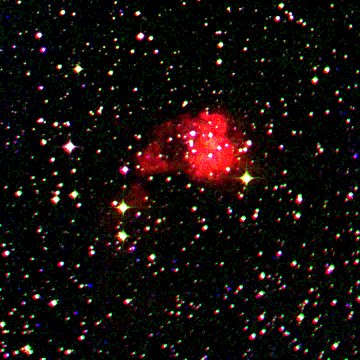RCW 87
Coordinates: (320.2°, 0.8°)
[ Catalog | Explorer | SIMBAD ]
According to a 1987 paper from the Georgelins, RCW 87, 88 and 89 are part of the same structure located at a distance of 3000-4000 pc, most likely closer to 3000 pc. RCW 87 and 88 are HII regions.
According to a 2006 paper, RCW 87 may contain one of the most massive young star clusters (10300 solar masses) known in the Milky Way. [BDB2003] G320.15+00.79 is about 20-25 million years old, has a distance of 7600 parsecs, and its brightest members have evolved into red supergiants.
According to one 2011 paper, RCW 87 is much closer at 1230 pc. A second 2011 paper gives a 2700 pc kinematic estimate.
RCW 87 appears to be immersed in a larger diffuse nebula that includes IRAS 14597-5728, sometimes called the Black Widow nebula because of its appearance in infrared. However, Avedisova places IRAS 14597-5728 in a separate star formation region.
You can see the full extent of RCW 87 in this Spitzer infrared image.
RCW 87, 88 and 89 are part of the same structure located at a distance of 3000-4000 pc, most likely closer to 3000 pc. RCW 87 and 88 are both HII regions.[2]
A recent paper concludes that RCW 87 is most likely ionised by stars within [BDB2003] G320.15+00.79, but that this is a more ordinary star cluster with one B1 and three B3 stars at a relatively close distance of 1230 +/ 300 pc. [3]
Notes
1. ^ Borissova, J., Ivanov, V. D., Minniti, D., et al. (2006). "Discovery of new Milky Way star cluster candidates in the 2 MASS point source catalog. V. Follow-up observations of the young stellar cluster candidates RCW 87, [BDSB2003] 164 and [DBSB2003] 172", Astronomy and Astrophysics, Vol. 455, 923-930. [2006A&A...455..923B]
2. ^ Georgelin, Y. M., Boulesteix, J., Georgelin, Y. P., et al. (1987). "Galactic structure around longitude L = 317 deg determined from CIGALE observations", Astronomy and Astrophysics, Vol. 174, 257-269. [1987A&A...174..257G]
3. ^ Pinheiro, M. C., Copetti, M. V. F., & Oliveira, V. A. (2010). "Spectral classification and distance determination of stars in nine southern Galactic H II regions", Astronomy and Astrophysics, Vol. 521, A26. [2010A&A...521A..26P]
Distance estimates
3000 pc [1987A&A...174..257G]7600 pc [2006A&A...455..923B]
1230 pc +/- 300 [2010A&A...521A..26P]
2700 pc [2011MNRAS.411..705M]
Links
[ DSS | ADS | ADS Abstract ]
map | book | blog | gallery | sources

This image was created using the POSS-II/UKSTU data of the Digitized Sky Survey and SuperCOSMOS using the process described here.
According to my correspondence with the Royal Observatory Edinburgh and the Space Telescope Science Institute, I am allowed to use the POSS-II/UKSTU data to create and display images for non-commercial purposes so long as I include this fine print for the SuperCOSMOS data:
Use of these images is courtesy of the UK Schmidt Telescope (copyright in which is owned by the Particle Physics and Astronomy Research Council of the UK and the Anglo-Australian Telescope Board) and the Southern Sky Survey as created by the SuperCOSMOS measuring machine and are reproduced here with permission from the Royal Observatory Edinburgh.
and this acknowledgement taken from the DSS site:
The Digitized Sky Surveys were produced at the Space Telescope Science Institute under U.S. Government grant NAG W-2166. The images of these surveys are based on photographic data obtained using the Oschin Schmidt Telescope on Palomar Mountain and the UK Schmidt Telescope. The plates were processed into the present compressed digital form with the permission of these institutions.
The Second Palomar Observatory Sky Survey (POSS-II) was made by the California Institute of Technology with funds from the National Science Foundation, the National Geographic Society, the Sloan Foundation, the Samuel Oschin Foundation, and the Eastman Kodak Corporation.
The UK Schmidt Telescope was operated by the Royal Observatory Edinburgh, with funding from the UK Science and Engineering Research Council (later the UK Particle Physics and Astronomy Research Council), until 1988 June, and thereafter by the Anglo-Australian Observatory. The blue plates of the southern Sky Atlas and its Equatorial Extension (together known as the SERC-J), as well as the Equatorial Red (ER), and the Second Epoch [red] Survey (SES) were all taken with the UK Schmidt.
The "Second Epoch Survey" of the southern sky was made by the Anglo-Australian Observatory (AAO) with the UK Schmidt Telescope. Plates from this survey have been digitized and compressed by the ST ScI. The digitized images are copyright ? 1993-5 by the Anglo-Australian Observatory Board, and are distributed herein by agreement.
The "Equatorial Red Atlas" of the southern sky was made with the UK Schmidt Telescope. Plates from this survey have been digitized and compressed by the ST ScI. The digitized images are copyright ? 1992-5, jointly by the UK SERC/PPARC (Particle Physics and Astronomy Research Council, formerly Science and Engineering Research Council) and the Anglo-Australian Telescope Board, and are distributed herein by agreement.
The compressed files of the "Palomar Observatory - Space Telescope Science Institute Digital Sky Survey" of the northern sky, based on scans of the Second Palomar Sky Survey are copyright ? 1993-1995 by the California Institute of Technology and are distributed herein by agreement. The compressed files of the "Palomar Observatory - Space Telescope Science Institute Digital Sky Survey" of the northern sky, based on scans of the Second Palomar Sky Survey are copyright ? 1993-1995 by the California Institute of Technology and are distributed herein by agreement.